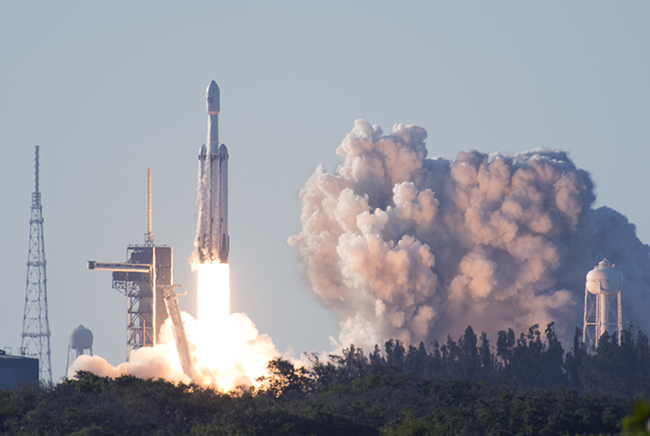
SpaceX's Falcon Heavy Arabsat 6A lifts off from Space Launch Complex 39A at Kennedy Space Center, Fla., April 12, 2019. Air Force photo by 2nd Lt. Alex Preisser.
An initial work plan that acts as a blueprint for establishing a Space Force, signed by Air Force Secretary Heather Wilson, heads to Capitol Hill, but the plan remains “long on questions and short on answers,” said Maj. Gen. Clint Crosier, director of the Space Force planning task force, at an AFA Gabriel Chapter luncheon on May 8.
The plan envisions the incremental steps needed to stand up a fully operational Space Force within five years.
“What it includes is things like, here’s the timeline in which you must determine which of the Army, Navy, or Air Forces are in,” Crosier said. “Here’s the exact decision point where we need to make a decision about the total number of people so that we can catch the [Program Objective Memorandum], or the planning cycle, to affect these decisions.”
Meanwhile, a new Congressional Budget Office report also released May 8 projects the costs of creating a new Space service, a new Space Command, and a new development agency could cost between $3 billion and $5 billion in personnel costs in the first year.
Many outstanding questions remain about what the Space Force will include and whether bringing both the Air Force Space and Missile Systems Center and the new Space Development Agency under its umbrella would duplicate effort. Crosier said he believes that placing those two organizations within the Space Force would make the transition easier.
As Congress hashes out its fiscal 2020 defense policy and spending bills over the coming months, lawmakers also have a chance to weigh in on what a future organization intended to manage space warfighters should look like. Any Space Force legislation that may be considered as part of those bills is expected to contain some changes from what the Pentagon submitted earlier this year.
Crosier said he agreed to sign on as a top Space Force planner once he was sure the organization would be co-equal with the air component.
“As a space professional who spent some 30 years of my life flying satellites, launching rockets, and that sort of thing, when the idea first came up about a separate Space Force outside the Department of Air Force … I was absolutely opposed,” Crosier said. “I think it makes no sense at all to try to stand up a service that un-integrates everything we’ve worked to integrate over the last two decades.”
The DOD still intends to eventually break out a Space Force as a standalone department in the future. Whichever direction the new service takes, Crosier said, he’s confident senior leaders will make the right decision.
“Whatever they choose to do, it has to be fused, integrated in a significant way, all the way at the tactical level, with all of our other forces—the Air Force in particular,” he said.
The Pentagon argues growing the Space Force over the next five years will cost $2 billion, including $72 million in fiscal 2020, and about $500 million each year once the organization is fully established. Defense officials expect it will encompass up to 20,000 employees.
The CBO, however, projects that creating a sixth military service would require 4,100 to 6,800 new overhead and management positions on top of the nearly 23,000 workers already in space-related jobs who could transfer to the Space Force, growing Defense Department costs by $820 million to $1.3 billion a year. CBO also estimates DOD would spend $1.1 billion to $3 billion on one-time costs.
“Congress needs to make sure the Air Force and other services actually transfer all of the space-related support and HQ personnel to the new service,” Todd Harrison, a defense budget expert at the Center for Strategic and International Studies, said on Twitter. “Otherwise, new people will need to be hired to do the jobs of the people that don’t transfer over, and that will jack up the cost.”
Overall, CBO anticipates the Trump administration’s proposal to revive US Space Command as well as create a new Space Force and Space Development Agency would “require 5,700 to 9,700 new positions for overhead and management, increase DOD’s annual costs by $1.1 billion to $1.9 billion, and incur one-time costs of $1.8 billion to $4.7 billion.”